Introduction to MVVM Framework
Download as pptx, pdf1 like2,088 views
The document introduces the Model-View-ViewModel (MVVM) pattern. It describes MVVM as replacing the controller with a view model to facilitate data binding between the view and model. The key components in MVVM are the model, which represents the business domain and data access logic; the view, which displays data and collects user input; and the view model, which acts as an intermediary between the view and model by aggregating data and notifying the view of changes. The document provides examples of how MVVM is implemented in Silverlight applications using the MVVM Light Toolkit to define commands and handle events and messaging between the view and view model.
1 of 15
Downloaded 106 times
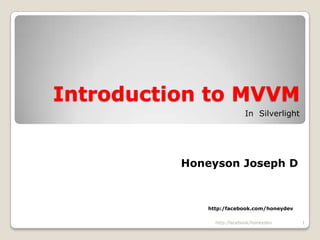
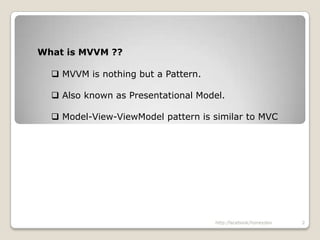
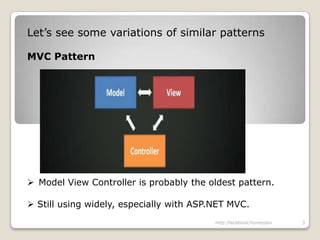
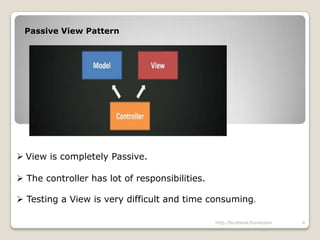
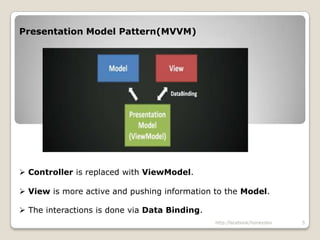
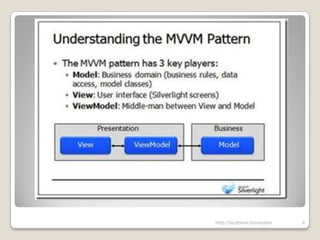
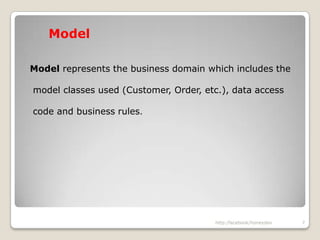

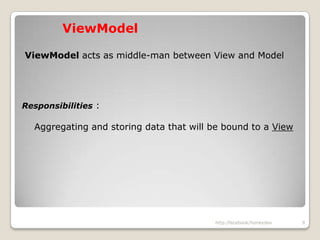
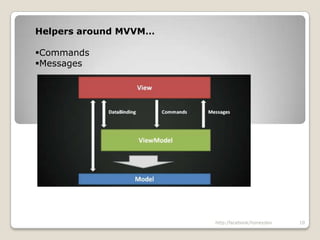
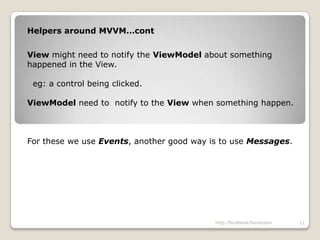

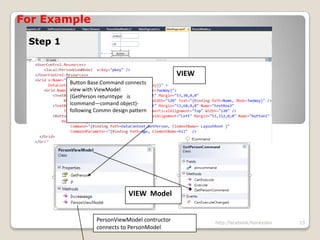
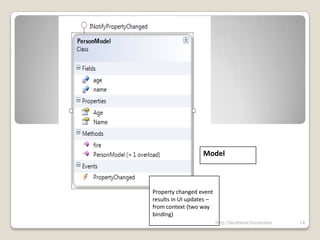
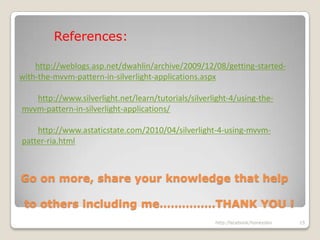
Ad
Recommended
Mantis Presentation
Mantis Presentationmelissasamesame
╠²
This document provides instructions for reporting bugs in Mantis, including how to log in and select a project, qualify an issue by describing its category, reproducibility, severity, and priority, and how to fully describe an issue with a summary, steps to reproduce, and any additional details. Users are instructed to test issues on multiple browsers where possible and provide screenshots and file uploads to aid understanding of the reported bug.CV - Ness
CV - NessVanessa Bishop
╠²
Vanessa Bishop has over 15 years of experience in administrative and compliance roles, including positions at Maranoa Crane Hire, Titan Energy Services, LCR Group, Boom Logistics, and Queensland Police Service. She holds qualifications in small business management, workplace health and safety, and management. Her skills include team building, negotiation, project management, problem solving, and strong communication and client service abilities.MVVM - Model View ViewModel
MVVM - Model View ViewModelDareen Alhiyari
╠²
This document provides an introduction to the MVVM design pattern. It describes MVVM as separating an application into three main parts: the Model, the View, and the ViewModel. The Model manages the data and business logic. The View displays the user interface. The ViewModel acts as an intermediary between the Model and View, providing the data and handling user input. Benefits of MVVM include loose coupling between components, testable code, and maintainable code. Some common MVVM frameworks are also listed.Model View ViewModel
Model View ViewModelDoncho Minkov
╠²
This document provides an introduction to the Model-View-ViewModel (MVVM) architectural pattern, which is commonly used in WPF and Silverlight applications. It describes the key components of MVVM - the View, Model, and ViewModel layers. The ViewModel acts as a mediator between the View and Model layers, exposing properties and commands to the View. Changes in the Model are communicated to the View via notification events using the INotifyPropertyChanged interface. The document includes a simple example of implementing MVVM to manage a list of names, and discusses how real-world applications can utilize this pattern.Training: MVVM Pattern
Training: MVVM PatternBetclic Everest Group Tech Team
╠²
The document provides a comprehensive overview of the MVVM (Model-View-ViewModel) architectural pattern, detailing its historical background, components, and advantages such as loose coupling, maintainability, and testability. It also compares MVVM to other patterns, discusses common scenarios, and highlights popular frameworks in the .NET environment. Additionally, it includes practical examples and use cases for implementing MVVM in applications, particularly within various programming environments like AngularJS.Understanding The MVVM Pattern (TechDays Belgium)
Understanding The MVVM Pattern (TechDays Belgium)Laurent Bugnion
╠²
The document discusses the MVVM (Model-View-ViewModel) pattern, its definitions, components, and importance in WPF/Silverlight environments. It covers implementation aspects, including commands, messaging, and the MVVM Light Toolkit, emphasizing testability and design-time data handling. The document also addresses common misconceptions about MVVM and its applicability in various scenarios, including its limitations and flaws.Adopting MVVM
Adopting MVVMJohn Cumming
╠²
The document discusses adopting the MVVM pattern for WPF applications. It addresses problems MVVM solves like tightly coupled code that is difficult to maintain and test. It provides an overview of MVVM, separating concerns into the View, ViewModel and Model layers. It also discusses constructing an MVVM application, including dependency injection, bindable properties, commands and design time data. Finally, it provides a simple example application converted to MVVM, improving testability, decoupling and extensibility.MVVM+MEF in Silvelight - W 2010ebday
MVVM+MEF in Silvelight - W 2010ebdayRicardo Fiel
╠²
The document discusses the integration of the MVVM (Model-View-ViewModel) pattern with MEF (Managed Extensibility Framework) in Silverlight applications. It outlines the roles of the view, view model, and model, emphasizing their interactions and highlighting the benefits and variations of MVVM implementations. Additionally, it introduces the MEF framework as a way to build extensible applications and showcases practical examples of applying these concepts in development.MVVM and Prism
MVVM and PrismBilal Ahmed
╠²
This document provides an overview of the MVVM and PRISM design patterns. It discusses that MVVM separates presentation logic from business logic through a View, ViewModel and Model architecture. The ViewModel acts as a data binder between the View and Model, and changes in the Model and ViewModel are communicated via the INotifyPropertyChanged interface. PRISM is a framework that implements patterns like MVVM, dependency injection, commands and model validation to build loosely coupled WPF and Windows applications.Windows Phone App with MVVM design patten
Windows Phone App with MVVM design pattenKamalakannan Annamalai
╠²
The document discusses the Model-View-ViewModel (MVVM) pattern, which separates an application into three main components: the model, the view, and the view model. It explains that MVVM is best suited for WPF, Silverlight, and Windows Phone applications because these platforms internally use MVVM. The document also describes related patterns like MVC and Presentation Model, how MVVM enables separation of design and runtime code for "blendability", and how to bridge the view and view model using data binding and commands. It debunks common myths about MVVM and recommends the MVVM Light Toolkit for simplifying MVVM applications.Presentation Model
Presentation ModelAlex Miranda
╠²
The document summarizes the presentation model pattern and Model-View-ViewModel (MVVM) design pattern. It discusses how MVVM is an implementation of the presentation model pattern for WPF and Silverlight applications. It outlines key aspects of MVVM like separating the view and view model, using XAML for views, data binding between views and view models, commands, validation, messaging between components, and view model locators. The document provides examples of how to implement features like data binding, commands, and validation using MVVM.Building an enterprise app in silverlight 4 and NHibernate
Building an enterprise app in silverlight 4 and NHibernatebwullems
╠²
This document discusses building an enterprise application using Silverlight, NHibernate, and following CQRS and MVVM patterns. It recommends using OData to implement the query model in CQRS and NHibernate for the domain model. It then covers implementing the front-end using MVVM principles in Silverlight, including using view models, commands, and an event aggregator for communication between view models. Demo code is provided for various aspects like OData queries, NHibernate usage, implementing a base view model, locator pattern, MEF, and unit testing view models.Mvvm in the real world tccc10
Mvvm in the real world tccc10Bryan Anderson
╠²
This document discusses MVVM architecture patterns and common issues related to implementing MVVM. It begins with defining key concepts in MVVM like INotifyPropertyChanged, data binding, value converters, dependency properties, user controls and commands. It then summarizes the roles and responsibilities of the Model, View and ViewModel. Several common issues that arise with MVVM implementations are discussed along with recommended solutions.Ios models
Ios modelsJUDYFLAVIAB
╠²
This document compares and contrasts three architectural patterns: MVC, MVP, and MVVM. It provides an overview of each pattern, including what they are, why they are used, examples of how they are implemented in different Microsoft technologies like ASP.NET MVC, Web Forms, and Silverlight. It concludes with guidance on which pattern to use based on the type of application, with MVC recommended for disconnected web apps, MVP for apps with existing UI logic like Web Forms, and MVVM for apps using WPF or Silverlight that require two-way data binding.MVVM ( Model View ViewModel )
MVVM ( Model View ViewModel )Ahmed Emad
╠²
The document provides an overview of the traditional UI development approach and introduces the Model-View-ViewModel (MVVM) architectural pattern. It defines the key components of MVVM - the Model, View, and ViewModel - and describes how they interact through data binding, commands, and notifications. The summary highlights MVVM's separation of concerns, support for independent development and testing of components, and facilitation of UI redevelopment.UI Design Patterns
UI Design Patternsaamiralihussain
╠²
UI design patterns provide reusable solutions to common problems in user interface design. There are several types of design patterns including MVC, MVP, and MVVM. MVC separates an application into three components - the model, the view, and the controller. MVP is similar to MVC but replaces the controller with a presenter. MVVM builds on MVC and MVP by introducing a view model that acts as a mediator between the view and model layers. Design patterns improve maintainability, testability, and extensibility by reducing coupling between different application components.Mvc, mvp & mvvm (erp)
Mvc, mvp & mvvm (erp)Ayesha Maqsood
╠²
This document compares and contrasts the MVC, MVP, and MVVM design patterns. MVC divides an application into the model, view, and controller components. MVP is similar but replaces the controller with a presenter. MVVM supports two-way data binding between the view and view model, enabling automatic propagation of changes. It divides an application into the model, view, and view model. The view model acts as a bridge between the view and model, manipulating the model based on user input and updating the view.Advanced MVVM in Windows 8
Advanced MVVM in Windows 8Gill Cleeren
╠²
The document provides an overview and agenda for a webinar on advanced MVVM development in Windows 8. It introduces the speaker and covers topics like thinking about the Modern UI, MVVM overview, building blocks like commanding and messaging, application architecture, navigation, data access, data binding to Windows 8 controls, working with contracts and tiles, lifecycle and state management, and unit testing. Attendees can win prizes by completing a post-webinar survey. The webinar aims to show how to build Windows 8 apps using MVVM patterns and architectures.Mvc vs mvp vs mvvm a guide on architecture presentation patterns
Mvc vs mvp vs mvvm a guide on architecture presentation patternsConcetto Labs
╠²
This document provides an overview of common architecture patterns for mobile and web applications: MVC, MVP, and MVVM. It explains the core components and advantages of each pattern. MVC separates an application into the model, view, and controller layers. MVP is similar but replaces the controller with a presenter. MVVM organizes code into testable, maintainable applications using the model, view, and view model layers with data binding between view and view model. Choosing an architecture depends on factors like framework used, development team structure, and specific project needs.Introduction to WPF and MVVM
Introduction to WPF and MVVMSirar Salih
╠²
This document introduces Windows Presentation Foundation (WPF) and the Model-View-ViewModel (MVVM) pattern. It discusses how WPF uses XAML and DirectX for 2D/3D rendering and animation. It also explains how MVVM separates user interface logic from application logic and data models. Finally, it describes how WPF and MVVM can be combined to create maintainable, testable applications using data binding and commands to connect views to view models.Ljubomir zivanovic understandingmvvm-designpattern (1)
Ljubomir zivanovic understandingmvvm-designpattern (1)Gnana Sekaran
╠²
This document discusses the MVVM design pattern and how it can help developers transition to new technologies like Silverlight and WP7. It begins by noting the huge number of new technologies available and the need for an efficient way to work with them. It then introduces MVVM as a pattern that solves issues around maintainability, testability, and separation of concerns. The document demonstrates MVVM through a sample WP7 app and notes tools that support MVVM development. It also discusses how MVVM applies to ASP.NET and other platforms.MVVM
MVVMVictor-Andrei Filimon
╠²
This document provides an overview of the Model-View-ViewModel (MVVM) design pattern. It defines MVVM as splitting the user interface into three components: the Model contains the application's data; the View displays the data and handles user input; and the ViewModel acts as a mediator between the Model and View. The document discusses WPF concepts like bindings and data templates that enable MVVM. It notes advantages like testability and separation of concerns, and disadvantages like potential overhead. Examples are provided and references for further reading.Mvvm
MvvmRajeev Ranjan Singh
╠²
The document discusses the Model-View ViewModel (MVVM) design pattern as an alternative to the standard iOS MVC pattern. MVVM decouples the UI logic from the business logic by placing the business logic in a ViewModel class. This results in thinner, more flexible view controllers that are easier to maintain. The MVVM pattern consists of a data model class, view/view controller classes that handle the UI, and a ViewModel class that acts as the connection between the model and view/view controller. Benefits of MVVM include quicker changes to workflows and code reuse across view controllers.Design Pattern - MVC, MVP and MVVM
Design Pattern - MVC, MVP and MVVMMudasir Qazi
╠²
The document compares three design patterns: MVC, MVP, and MVVM, highlighting their definitions, architectures, and advantages and disadvantages. Each pattern emphasizes separation of concerns, allowing for more maintainable and testable applications, but they also have unique characteristics that make them suitable for different scenarios. The document concludes with a summary of the distinctions between user input responses across these patterns.MVVM Light Toolkit
Works Great, Less Complicated
MVVM Light Toolkit
Works Great, Less Complicatedmdc11
╠²
The document discusses the MVVM Light toolkit, describing it as a lightweight toolkit that supports the MVVM pattern for WPF and Silverlight applications. It provides an overview of the toolkit, demonstrates its use in a sample application, and compares it to other MVVM toolkits like Prism and Caliburn Micro. The demonstration shows how MVVM Light addresses issues that came up when applying MVVM to the sample application without a toolkit.How I Accidentally Discovered MVVM
How I Accidentally Discovered MVVMBradford Dillon
╠²
The document discusses how the speaker accidentally discovered the MVVM architectural pattern while working on an iOS project. Some key points made in the document include:
1. MVVM is an enhancement of MVC that separates the view and controller by introducing a view model.
2. Using MVVM and view models allows for better refactoring, reuse of code, and avoids large view controllers.
3. The speaker provides an example of how MVVM can be applied to an iOS table view to demonstrate its benefits and outlines what was learned about MVVM from adopting it.Applied MVVM in Windows 8 apps: not your typical MVVM session!
Applied MVVM in Windows 8 apps: not your typical MVVM session!Microsoft Developer Network (MSDN) - Belgium and Luxembourg
╠²
This document provides an introduction and agenda for a presentation on building Windows 8 applications using the Model-View-ViewModel (MVVM) pattern. It includes an overview of MVVM, the core building blocks of MVVM including commands, view model locators, and messaging. It also discusses application architecture topics like dependency injection, navigation, data access, and lifecycle management. The presentation aims to show how knowledge of MVVM from other technologies like WPF and Silverlight can be leveraged to build Windows 8 apps using the same pattern.Portable Class Libraries and MVVM
Portable Class Libraries and MVVMAndreas Kuntner
╠²
The document explains the use of portable class libraries and the MVVM (Model-View-ViewModel) pattern in cross-platform application development, highlighting how to structure and separate platform-specific and reusable code. It emphasizes principles of the MVVM pattern, including encapsulation, data binding, and maintainability, while providing practical examples of implementation. Resources and sample applications are also included for further exploration of the topic.From Manual to Auto Searching- FME in the Driver's Seat
From Manual to Auto Searching- FME in the Driver's SeatSafe Software
╠²
Finding a specific car online can be a time-consuming task, especially when checking multiple dealer websites. A few years ago, I faced this exact problem while searching for a particular vehicle in New Zealand. The local classified platform, Trade Me (similar to eBay), wasnŌĆÖt yielding any results, so I expanded my search to second-hand dealer sitesŌĆöonly to realise that periodically checking each one was going to be tedious. ThatŌĆÖs when I noticed something interesting: many of these websites used the same platform to manage their inventories. Recognising this, I reverse-engineered the platformŌĆÖs structure and built an FME workspace that automated the search process for me. By integrating API calls and setting up periodic checks, I received real-time email alerts when matching cars were listed. In this presentation, IŌĆÖll walk through how I used FME to save hours of manual searching by creating a custom car-finding automation system. While FME canŌĆÖt buy a car for youŌĆöyetŌĆöit can certainly help you find the one youŌĆÖre after!More Related Content
Similar to Introduction to MVVM Framework (20)
MVVM and Prism
MVVM and PrismBilal Ahmed
╠²
This document provides an overview of the MVVM and PRISM design patterns. It discusses that MVVM separates presentation logic from business logic through a View, ViewModel and Model architecture. The ViewModel acts as a data binder between the View and Model, and changes in the Model and ViewModel are communicated via the INotifyPropertyChanged interface. PRISM is a framework that implements patterns like MVVM, dependency injection, commands and model validation to build loosely coupled WPF and Windows applications.Windows Phone App with MVVM design patten
Windows Phone App with MVVM design pattenKamalakannan Annamalai
╠²
The document discusses the Model-View-ViewModel (MVVM) pattern, which separates an application into three main components: the model, the view, and the view model. It explains that MVVM is best suited for WPF, Silverlight, and Windows Phone applications because these platforms internally use MVVM. The document also describes related patterns like MVC and Presentation Model, how MVVM enables separation of design and runtime code for "blendability", and how to bridge the view and view model using data binding and commands. It debunks common myths about MVVM and recommends the MVVM Light Toolkit for simplifying MVVM applications.Presentation Model
Presentation ModelAlex Miranda
╠²
The document summarizes the presentation model pattern and Model-View-ViewModel (MVVM) design pattern. It discusses how MVVM is an implementation of the presentation model pattern for WPF and Silverlight applications. It outlines key aspects of MVVM like separating the view and view model, using XAML for views, data binding between views and view models, commands, validation, messaging between components, and view model locators. The document provides examples of how to implement features like data binding, commands, and validation using MVVM.Building an enterprise app in silverlight 4 and NHibernate
Building an enterprise app in silverlight 4 and NHibernatebwullems
╠²
This document discusses building an enterprise application using Silverlight, NHibernate, and following CQRS and MVVM patterns. It recommends using OData to implement the query model in CQRS and NHibernate for the domain model. It then covers implementing the front-end using MVVM principles in Silverlight, including using view models, commands, and an event aggregator for communication between view models. Demo code is provided for various aspects like OData queries, NHibernate usage, implementing a base view model, locator pattern, MEF, and unit testing view models.Mvvm in the real world tccc10
Mvvm in the real world tccc10Bryan Anderson
╠²
This document discusses MVVM architecture patterns and common issues related to implementing MVVM. It begins with defining key concepts in MVVM like INotifyPropertyChanged, data binding, value converters, dependency properties, user controls and commands. It then summarizes the roles and responsibilities of the Model, View and ViewModel. Several common issues that arise with MVVM implementations are discussed along with recommended solutions.Ios models
Ios modelsJUDYFLAVIAB
╠²
This document compares and contrasts three architectural patterns: MVC, MVP, and MVVM. It provides an overview of each pattern, including what they are, why they are used, examples of how they are implemented in different Microsoft technologies like ASP.NET MVC, Web Forms, and Silverlight. It concludes with guidance on which pattern to use based on the type of application, with MVC recommended for disconnected web apps, MVP for apps with existing UI logic like Web Forms, and MVVM for apps using WPF or Silverlight that require two-way data binding.MVVM ( Model View ViewModel )
MVVM ( Model View ViewModel )Ahmed Emad
╠²
The document provides an overview of the traditional UI development approach and introduces the Model-View-ViewModel (MVVM) architectural pattern. It defines the key components of MVVM - the Model, View, and ViewModel - and describes how they interact through data binding, commands, and notifications. The summary highlights MVVM's separation of concerns, support for independent development and testing of components, and facilitation of UI redevelopment.UI Design Patterns
UI Design Patternsaamiralihussain
╠²
UI design patterns provide reusable solutions to common problems in user interface design. There are several types of design patterns including MVC, MVP, and MVVM. MVC separates an application into three components - the model, the view, and the controller. MVP is similar to MVC but replaces the controller with a presenter. MVVM builds on MVC and MVP by introducing a view model that acts as a mediator between the view and model layers. Design patterns improve maintainability, testability, and extensibility by reducing coupling between different application components.Mvc, mvp & mvvm (erp)
Mvc, mvp & mvvm (erp)Ayesha Maqsood
╠²
This document compares and contrasts the MVC, MVP, and MVVM design patterns. MVC divides an application into the model, view, and controller components. MVP is similar but replaces the controller with a presenter. MVVM supports two-way data binding between the view and view model, enabling automatic propagation of changes. It divides an application into the model, view, and view model. The view model acts as a bridge between the view and model, manipulating the model based on user input and updating the view.Advanced MVVM in Windows 8
Advanced MVVM in Windows 8Gill Cleeren
╠²
The document provides an overview and agenda for a webinar on advanced MVVM development in Windows 8. It introduces the speaker and covers topics like thinking about the Modern UI, MVVM overview, building blocks like commanding and messaging, application architecture, navigation, data access, data binding to Windows 8 controls, working with contracts and tiles, lifecycle and state management, and unit testing. Attendees can win prizes by completing a post-webinar survey. The webinar aims to show how to build Windows 8 apps using MVVM patterns and architectures.Mvc vs mvp vs mvvm a guide on architecture presentation patterns
Mvc vs mvp vs mvvm a guide on architecture presentation patternsConcetto Labs
╠²
This document provides an overview of common architecture patterns for mobile and web applications: MVC, MVP, and MVVM. It explains the core components and advantages of each pattern. MVC separates an application into the model, view, and controller layers. MVP is similar but replaces the controller with a presenter. MVVM organizes code into testable, maintainable applications using the model, view, and view model layers with data binding between view and view model. Choosing an architecture depends on factors like framework used, development team structure, and specific project needs.Introduction to WPF and MVVM
Introduction to WPF and MVVMSirar Salih
╠²
This document introduces Windows Presentation Foundation (WPF) and the Model-View-ViewModel (MVVM) pattern. It discusses how WPF uses XAML and DirectX for 2D/3D rendering and animation. It also explains how MVVM separates user interface logic from application logic and data models. Finally, it describes how WPF and MVVM can be combined to create maintainable, testable applications using data binding and commands to connect views to view models.Ljubomir zivanovic understandingmvvm-designpattern (1)
Ljubomir zivanovic understandingmvvm-designpattern (1)Gnana Sekaran
╠²
This document discusses the MVVM design pattern and how it can help developers transition to new technologies like Silverlight and WP7. It begins by noting the huge number of new technologies available and the need for an efficient way to work with them. It then introduces MVVM as a pattern that solves issues around maintainability, testability, and separation of concerns. The document demonstrates MVVM through a sample WP7 app and notes tools that support MVVM development. It also discusses how MVVM applies to ASP.NET and other platforms.MVVM
MVVMVictor-Andrei Filimon
╠²
This document provides an overview of the Model-View-ViewModel (MVVM) design pattern. It defines MVVM as splitting the user interface into three components: the Model contains the application's data; the View displays the data and handles user input; and the ViewModel acts as a mediator between the Model and View. The document discusses WPF concepts like bindings and data templates that enable MVVM. It notes advantages like testability and separation of concerns, and disadvantages like potential overhead. Examples are provided and references for further reading.Mvvm
MvvmRajeev Ranjan Singh
╠²
The document discusses the Model-View ViewModel (MVVM) design pattern as an alternative to the standard iOS MVC pattern. MVVM decouples the UI logic from the business logic by placing the business logic in a ViewModel class. This results in thinner, more flexible view controllers that are easier to maintain. The MVVM pattern consists of a data model class, view/view controller classes that handle the UI, and a ViewModel class that acts as the connection between the model and view/view controller. Benefits of MVVM include quicker changes to workflows and code reuse across view controllers.Design Pattern - MVC, MVP and MVVM
Design Pattern - MVC, MVP and MVVMMudasir Qazi
╠²
The document compares three design patterns: MVC, MVP, and MVVM, highlighting their definitions, architectures, and advantages and disadvantages. Each pattern emphasizes separation of concerns, allowing for more maintainable and testable applications, but they also have unique characteristics that make them suitable for different scenarios. The document concludes with a summary of the distinctions between user input responses across these patterns.MVVM Light Toolkit
Works Great, Less Complicated
MVVM Light Toolkit
Works Great, Less Complicatedmdc11
╠²
The document discusses the MVVM Light toolkit, describing it as a lightweight toolkit that supports the MVVM pattern for WPF and Silverlight applications. It provides an overview of the toolkit, demonstrates its use in a sample application, and compares it to other MVVM toolkits like Prism and Caliburn Micro. The demonstration shows how MVVM Light addresses issues that came up when applying MVVM to the sample application without a toolkit.How I Accidentally Discovered MVVM
How I Accidentally Discovered MVVMBradford Dillon
╠²
The document discusses how the speaker accidentally discovered the MVVM architectural pattern while working on an iOS project. Some key points made in the document include:
1. MVVM is an enhancement of MVC that separates the view and controller by introducing a view model.
2. Using MVVM and view models allows for better refactoring, reuse of code, and avoids large view controllers.
3. The speaker provides an example of how MVVM can be applied to an iOS table view to demonstrate its benefits and outlines what was learned about MVVM from adopting it.Applied MVVM in Windows 8 apps: not your typical MVVM session!
Applied MVVM in Windows 8 apps: not your typical MVVM session!Microsoft Developer Network (MSDN) - Belgium and Luxembourg
╠²
This document provides an introduction and agenda for a presentation on building Windows 8 applications using the Model-View-ViewModel (MVVM) pattern. It includes an overview of MVVM, the core building blocks of MVVM including commands, view model locators, and messaging. It also discusses application architecture topics like dependency injection, navigation, data access, and lifecycle management. The presentation aims to show how knowledge of MVVM from other technologies like WPF and Silverlight can be leveraged to build Windows 8 apps using the same pattern.Portable Class Libraries and MVVM
Portable Class Libraries and MVVMAndreas Kuntner
╠²
The document explains the use of portable class libraries and the MVVM (Model-View-ViewModel) pattern in cross-platform application development, highlighting how to structure and separate platform-specific and reusable code. It emphasizes principles of the MVVM pattern, including encapsulation, data binding, and maintainability, while providing practical examples of implementation. Resources and sample applications are also included for further exploration of the topic.Applied MVVM in Windows 8 apps: not your typical MVVM session!
Applied MVVM in Windows 8 apps: not your typical MVVM session!Microsoft Developer Network (MSDN) - Belgium and Luxembourg
╠²
Recently uploaded (20)
From Manual to Auto Searching- FME in the Driver's Seat
From Manual to Auto Searching- FME in the Driver's SeatSafe Software
╠²
Finding a specific car online can be a time-consuming task, especially when checking multiple dealer websites. A few years ago, I faced this exact problem while searching for a particular vehicle in New Zealand. The local classified platform, Trade Me (similar to eBay), wasnŌĆÖt yielding any results, so I expanded my search to second-hand dealer sitesŌĆöonly to realise that periodically checking each one was going to be tedious. ThatŌĆÖs when I noticed something interesting: many of these websites used the same platform to manage their inventories. Recognising this, I reverse-engineered the platformŌĆÖs structure and built an FME workspace that automated the search process for me. By integrating API calls and setting up periodic checks, I received real-time email alerts when matching cars were listed. In this presentation, IŌĆÖll walk through how I used FME to save hours of manual searching by creating a custom car-finding automation system. While FME canŌĆÖt buy a car for youŌĆöyetŌĆöit can certainly help you find the one youŌĆÖre after!Raman Bhaumik - Passionate Tech Enthusiast
Raman Bhaumik - Passionate Tech EnthusiastRaman Bhaumik
╠²
A Junior Software Developer with a flair for innovation, Raman Bhaumik excels in delivering scalable web solutions. With three years of experience and a solid foundation in Java, Python, JavaScript, and SQL, she has streamlined task tracking by 20% and improved application stability.The Future of Technology: 2025-2125 by Saikat Basu.pdf
The Future of Technology: 2025-2125 by Saikat Basu.pdfSaikat Basu
╠²
A peek into the next 100 years of technology. From Generative AI to Global AI networks to Martian Colonisation to Interstellar exploration to Industrial Nanotechnology to Artificial Consciousness, this is a journey you don't want to miss. Which ones excite you the most? Which ones are you apprehensive about? Feel free to comment! Let the conversation begin!Oh, the Possibilities - Balancing Innovation and Risk with Generative AI.pdf
Oh, the Possibilities - Balancing Innovation and Risk with Generative AI.pdfPriyanka Aash
╠²
Oh, the Possibilities - Balancing Innovation and Risk with Generative AIcnc-processing-centers-centateq-p-110-en.pdf
cnc-processing-centers-centateq-p-110-en.pdfAmirStern2
╠²
ū×ū©ūøū¢ ūóūÖūæūĢūōūÖūØ ū¬ūóū®ūÖūÖū¬ūÖ ūæūóū£ 3/4/5 ū”ūÖū©ūÖūØ, ūóūō 22 ūöūŚū£ūżūĢū¬ ūøū£ūÖūØ ūóūØ ūøū£ ūÉūżū®ū©ūĢūÖūĢū¬ ūöūóūÖūæūĢūō ūöūōū©ūĢū®ūĢū¬.╠²ūæūóū£ ū®ūśūŚ ūóūæūĢūōūö ūÆūōūĢū£ ūĢū×ūŚū®ūæ ūĀūĢūŚ ūĢū¦ū£ ū£ūöūżūóū£ūö ūæū®ūżūö ūöūóūæū©ūÖū¬/ū©ūĢūĪūÖū¬/ūÉūĀūÆū£ūÖū¬/ūĪūżū©ūōūÖū¬/ūóū©ūæūÖū¬ ūĢūóūĢūō..
ū×ūĪūĢūÆū£ ū£ūæū”ūó ūżūóūĢū£ūĢū¬ ūóūÖūæūĢūō ū®ūĢūĀūĢū¬ ūöū×ū¬ūÉūÖū×ūĢū¬ ū£ūóūĀūżūÖūØ ū®ūĢūĀūÖūØ: ū¦ūÖūōūĢūŚ ūÉūĀūøūÖ, ūÉūĢūżū¦ūÖ, ūĀūÖūĪūĢū©, ūĢūøū©ūĪūĢūØ ūÉūĀūøūÖ.FIDO Seminar: New Data: Passkey Adoption in the Workforce.pptx
FIDO Seminar: New Data: Passkey Adoption in the Workforce.pptxFIDO Alliance
╠²
FIDO Seminar: New Data: Passkey Adoption in the WorkforceImproving Data Integrity: Synchronization between EAM and ArcGIS Utility Netw...
Improving Data Integrity: Synchronization between EAM and ArcGIS Utility Netw...Safe Software
╠²
Utilities and water companies play a key role in the creation of clean drinking water. The creation and maintenance of clean drinking water is becoming a critical problem due to pollution and pressure on the environment. A lot of data is necessary to create clean drinking water. For fieldworkers, two types of data are key: Asset data in an asset management system (EAM for example) and Geographic data in a GIS (ArcGIS Utility Network ). Keeping this type of data up to date and in sync is a challenge for many organizations, leading to duplicating data and creating a bulk of extra attributes and data to keep everything in sync. Using FME, it is possible to synchronize Enterprise Asset Management (EAM) data with the ArcGIS Utility Network in real time. Changes (creation, modification, deletion) in ArcGIS Pro are relayed to EAM via FME, and vice versa. This ensures continuous synchronization of both systems without daily bulk updates, minimizes risks, and seamlessly integrates with ArcGIS Utility Network services. This presentation focuses on the use of FME at a Dutch water company, to create a sync between the asset management and GIS.The Future of AI Agent Development Trends to Watch.pptx
The Future of AI Agent Development Trends to Watch.pptxLisa ward
╠²
The Future of AI Agent Development: Trends to Watch explores emerging innovations shaping smarter, more autonomous AI solutions for businesses and technology.
FIDO Seminar: Evolving Landscape of Post-Quantum Cryptography.pptx
FIDO Seminar: Evolving Landscape of Post-Quantum Cryptography.pptxFIDO Alliance
╠²
FIDO Seminar: Evolving Landscape of Post-Quantum CryptographyYou are not excused! How to avoid security blind spots on the way to production
You are not excused! How to avoid security blind spots on the way to productionMichele Leroux Bustamante
╠²
We live in an ever evolving landscape for cyber threats creating security risk for your production systems. Mitigating these risks requires participation throughout all stages from development through production delivery - and by every role including architects, developers QA and DevOps engineers, product owners and leadership. No one is excused! This session will cover examples of common mistakes or missed opportunities that can lead to vulnerabilities in production - and ways to do better throughout the development lifecycle.AI VIDEO MAGAZINE - June 2025 - r/aivideo
AI VIDEO MAGAZINE - June 2025 - r/aivideo1pcity Studios, Inc
╠²
AI VIDEO MAGAZINE - r/aivideo community newsletter ŌĆō Exclusive Tutorials: How to make an AI VIDEO from scratch, PLUS: How to make AI MUSIC, Hottest ai videos of 2025, Exclusive Interviews, New Tools, Previews, and MORE - JUNE 2025 ISSUE -FIDO Seminar: Authentication for a Billion Consumers - Amazon.pptx
FIDO Seminar: Authentication for a Billion Consumers - Amazon.pptxFIDO Alliance
╠²
FIDO Seminar: Authentication for a Billion Consumers - AmazonOWASP Barcelona 2025 Threat Model Library
OWASP Barcelona 2025 Threat Model LibraryPetraVukmirovic
╠²
Threat Model Library Launch at OWASP Barcelona 2025
https://owasp.org/www-project-threat-model-library/Enhance GitHub Copilot using MCP - Enterprise version.pdf
Enhance GitHub Copilot using MCP - Enterprise version.pdfNilesh Gule
╠²
║▌║▌▀Ż deck related to the GitHub Copilot Bootcamp in Melbourne on 17 June 2025Powering Multi-Page Web Applications Using Flow Apps and FME Data Streaming
Powering Multi-Page Web Applications Using Flow Apps and FME Data StreamingSafe Software
╠²
Unleash the potential of FME Flow to build and deploy advanced multi-page web applications with ease. Discover how Flow Apps and FMEŌĆÖs data streaming capabilities empower you to create interactive web experiences directly within FME Platform. Without the need for dedicated web-hosting infrastructure, FME enhances both data accessibility and user experience. Join us to explore how to unlock the full potential of FME for your web projects and seamlessly integrate data-driven applications into your workflows.PyCon SG 25 - Firecracker Made Easy with Python.pdf
PyCon SG 25 - Firecracker Made Easy with Python.pdfMuhammad Yuga Nugraha
╠²
Explore the ease of managing Firecracker microVM with the firecracker-python. In this session, I will introduce the basics of Firecracker microVM and demonstrate how this custom SDK facilitates microVM operations easily. We will delve into the design and development process behind the SDK, providing a behind-the-scenes look at its creation and features. While traditional Firecracker SDKs were primarily available in Go, this module brings a simplicity of Python to the table.Creating Inclusive Digital Learning with AI: A Smarter, Fairer Future
Creating Inclusive Digital Learning with AI: A Smarter, Fairer FutureImpelsys Inc.
╠²
Have you ever struggled to read a tiny label on a medicine box or tried to navigate a confusing website? Now imagine if every learning experience felt that wayŌĆöevery single day.
For millions of people living with disabilities, poorly designed content isnŌĆÖt just frustrating. ItŌĆÖs a barrier to growth. Inclusive learning is about fixing that. And today, AI is helping us build digital learning thatŌĆÖs smarter, kinder, and accessible to everyone.
Accessible learning increases engagement, retention, performance, and inclusivity for everyone. Inclusive design is simply better design.You are not excused! How to avoid security blind spots on the way to production
You are not excused! How to avoid security blind spots on the way to productionMichele Leroux Bustamante
╠²
Ad
Introduction to MVVM Framework
- 1. Introduction to MVVM In SilverlightHoneyson Joseph D http:/facebook.com/honeydev1http:/facebook/honeydev
- 2. What is MVVM ?? MVVM is nothing but a Pattern.
- 3. Also known as Presentational Model.
- 4. Model-View-ViewModelpattern is similar to MVC2http:/facebook/honeydev
- 5. LetŌĆÖs see some variations of similar patternsMVC PatternModel View Controller is probably the oldest pattern.
- 6. Still using widely, especially with ASP.NET MVC.3http:/facebook/honeydev
- 7. Passive View PatternView is completely Passive.
- 8. The controller has lot of responsibilities.
- 9. Testing a View is very difficult and time consuming.4http:/facebook/honeydev
- 10. Presentation Model Pattern(MVVM) Controlleris replaced with ViewModel.
- 11. Viewis more active and pushing information to the Model.
- 12. The interactions is done via Data Binding.5http:/facebook/honeydev
- 14. ModelModel represents the business domain which includes themodel classes used (Customer, Order, etc.), data accesscode and business rules.7http:/facebook/honeydev
- 15. View Viewin MVVM represents the screens that we build.Includes : 1.XAML files 2.code-beside files Responsibilities : 1.displaying data 2.collecting data from end users View isn't responsible for retrieving data, performing any business rules or validating data8http:/facebook/honeydev
- 16. ViewModelViewModel acts as middle-man between View and ModelResponsibilities : Aggregating and storing data that will be bound to a View9http:/facebook/honeydev
- 19. Helpers around MVVMŌĆ”contView might need to notify the ViewModelabout something happened in the View. eg: a control being clicked.ViewModelneed to notify to the View when something happen. For these we use Events, another good way is to use Messages.11http:/facebook/honeydev
- 20. MVVM in Silverlight We use MVVM Light Tools V.x
- 21. This is an open source MVVM very light Framework with 2 DLLsComponentsRelayCommand
- 22. Messenger
- 23. ViewModelBase. Also1. EventToCommandwhich can be used to get rid of annoyingWPF and SL Command binding limitations.2. DispatcherHelperfor multi-threaded applications.12http:/facebook/honeydev
- 24. For Example Step 1VIEWButton Base.Command connects view with ViewModel (GetPersonreturntype is IcommandŌĆöcomand object)- following Commn design patternVIEW ModelPersonViewModelcontructor connects to PersonModel13http:/facebook/honeydev
- 25. ModelProperty changed event results in UI updates ŌĆō from context (two way binding)14http:/facebook/honeydev
- 26. References:http://weblogs.asp.net/dwahlin/archive/2009/12/08/getting-started-with-the-mvvm-pattern-in-silverlight-applications.aspxhttp://www.silverlight.net/learn/tutorials/silverlight-4/using-the-mvvm-pattern-in-silverlight-applications/http://www.astaticstate.com/2010/04/silverlight-4-using-mvvm-patter-ria.htmlGo on more, share your knowledge that help to others including meŌĆ”ŌĆ”ŌĆ”ŌĆ”ŌĆ”THANK YOU !15http:/facebook/honeydev
